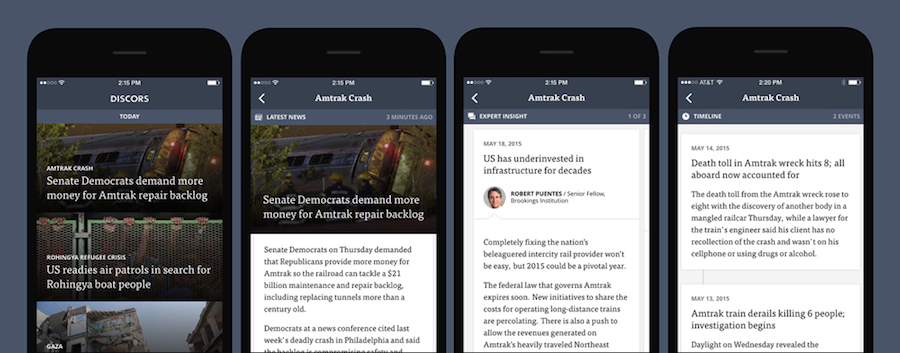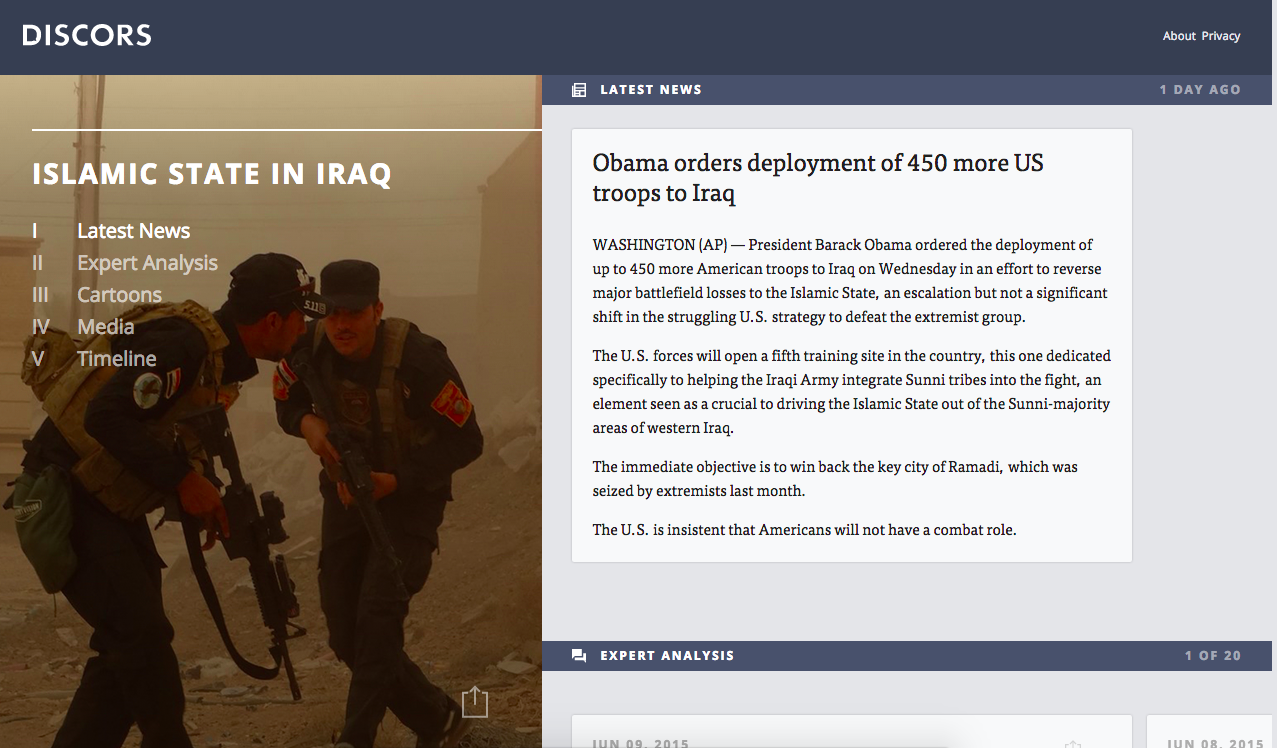
With the glut of news content online, a new generation of apps and websites aims to explain and provide context around the news. The latest entrant, launched last week, is Discors, which presents news stories alongside columns and analysis, photos, and a timeline, all in one stream. The stories are all shorter than 140 words, though users can expand them to get more information.
Discors enters a crowded field. There’s Vox, of course, the card-laden explainer site launched last year by Ezra Klein & Co. Then there’s Circa, the app that atomizes stories into their constituent parts. Timeline, which was released earlier this year, provides historical background for the news. And then there’s Fold, a platform developed by students at the MIT Media Lab meant to add context to stories.“The key differentiator for us, beyond just aggregating a lot of this opinion content, is having those insights run along side the news,” said Basil Enan, Discors’ founder and CEO. “I think it takes the news reader concept that was probably pioneered by a bunch of people, but most recently Circa and a lot of other ones, and provides a lot more depth than those apps have provided in the past.”
Discors doesn’t produce original stories; instead the app is populated by material from the Associated Press, Tribune News Service, and The Washington Post’s news service. It’s also published a handful of articles that were distributed under a Creative Commons license.
The app is in conversations with 10 to 12 publishers, universities, and think tanks and plans to launch with its first partners by the end of September, said Enan, who had previously launched the car insurance marketplaceCoverHound. The app is available as an iPhone app and as a responsive website. They plan to release an iPad app in the near future, with plans for an Android version by the end of the year.

 It’s free to use, though Discors plans to introduce a subscription model that will see it share revenue with its partners. Enan said they are still finalizing how the subscriptions would work, but users would likely be able to subscribe to a certain number of channels or purchase a more expensive subscription that would provide access to everything. Enan acknowledged that it will take time to build up a subscriber base, and Discors plans to offer a free ad-supported version of the app that would only allow access to a certain amount of the content.
It’s free to use, though Discors plans to introduce a subscription model that will see it share revenue with its partners. Enan said they are still finalizing how the subscriptions would work, but users would likely be able to subscribe to a certain number of channels or purchase a more expensive subscription that would provide access to everything. Enan acknowledged that it will take time to build up a subscriber base, and Discors plans to offer a free ad-supported version of the app that would only allow access to a certain amount of the content.
“We want the base of the pyramid to be as wide as possible,” he said. “Probably a majority of users for some amount of time will be using the free app.”
There are three people working on the app — Enan, his cofounder Akber Malik, and designer Azam Malik. (Akber and Azam are brothers.) So far, the trio has raised $150,000, mostly from their own contributions and from friends and family. They’re hoping to attract venture capital funding.
“Our goal wouldn’t necessarily be to bootstrap this up and grow slowly,” Enan said. “Our goal is to say, hey this is our proof of concept, our users love it, the publishers seem to like it, let’s grow it as quickly as we can.”
Still, the news app market that Discors is entering is tenuous. Circa, for example, has struggled to raise money and is now reportedly looking for a buyer. And platforms are increasingly using news as a means to convince users to spend more time in their apps — witness products like Facebook Instant Articles, Snapchat Discover, and Apple News.
Discors shares one element with those platform experiences — aiming to keep people inside the experience. The app purposefully doesn’t link out to sources and, for now, social sharing is only available on the web version of the app.

“We’ve drawn a pretty clear line, for now and for the foreseeable future, that we don’t link away to another site,” Enan said. “As part of the mobile experience, it’s important to have all the content living within the app and then we have some control over the layout and the delivery.”
At this point, Discors is assembling 15 to 20 stories per day. Most of the time, Discors will take the AP’s top stories and build out the rest of its coverage from there, adding in the Expert Insights, photos, and timeline. But on occasion, it’s decided to cover stories based on what its experts found important. “What they want to write about in a sense informs us about an issue that matters,” Enan said. Eventually, Discors wants to get to a point where it’s following hundreds of different stories each day.
Similarly, the current iteration of Discors only shows the top news items that the app is following each day. The plan, however, is to add personalization aspects to the app that lets users follow specific storylines, publications, or writers. They also want the app to recognize reader habits and suggest similar content.
“This isn’t set in stone, but you’ll be able to follow and or subscribe to individual channels — that could be a Mother Jones or National Review channel — as well as upvoting and other standard interactivity that you would have out there so we can learn what your preferences are.”